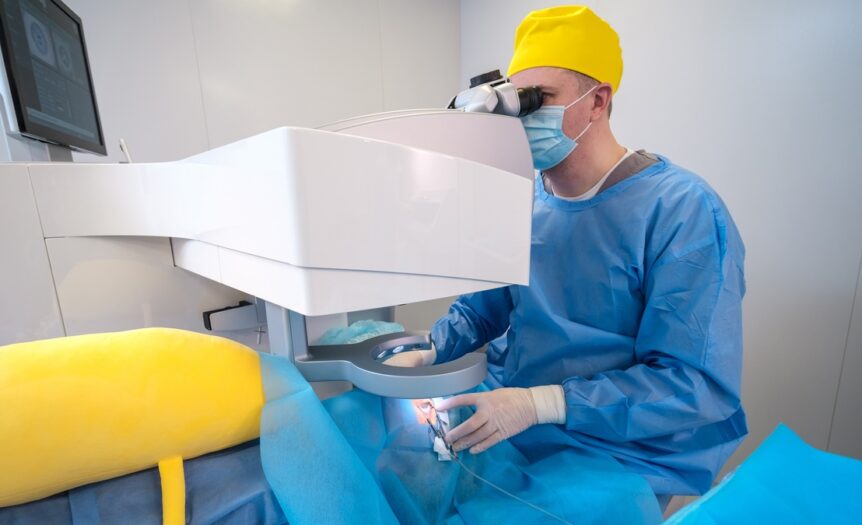Microsurgery is a critical aspect of ophthalmology, where precision and expertise come together to address complex eye conditions. Surgeons rely on various microsurgical tools to perform delicate procedures on tiny eye structures, making the right instruments essential for success. This guide will explore the basics of microsurgical tools in ophthalmology.
Introduction
Ophthalmic microsurgery treats intricate eye structures such as the cornea, retina, and lens. Procedures like cataract removal, corneal transplants, and retinal repairs demand exceptional accuracy. The tools can handle small, delicate tissues while minimizing trauma.
Essential Microsurgical Instruments
Ophthalmic surgery requires instruments tailored for unmatched precision. High-quality surgical tools are fundamental in maintaining control during complex procedures. These instruments include forceps, scissors, needle holders, cannulas, and powerful visualization systems.
Forceps and Graspers
Forceps are indispensable for handling delicate tissues and sutures. Surgeons choose between micro-forceps for grasping fine tissues and specialized graspers for holding specific materials like membranes or sutures. Instruments like these are crafted to provide an exceptional grip, allowing for precise manipulation during surgery.
Scissors
Scissors designed for ophthalmology, including lab scissors, are essential for making fine cuts in tissues or sutures. These scissors come in curved or straight designs, providing flexibility for different tasks. Lab scissors in ophthalmology are great for their sharp blades that deliver clean, accurate incisions, which are essential for minimizing tissue damage.
Needle Holders
Needle holders are vital for delicate suturing in ophthalmology. These instruments allow surgeons to maintain a secure grip on needles while performing precise stitching. Their ergonomic design and fine tips make suturing efficient and accurate, enhancing surgical outcomes.
Micro Cannulas and Irrigators
Cannulas and irrigators play an important role in maintaining an optimal surgical environment. Microsurgical cannulas can deliver and remove fluids, ensuring the targeted area remains clear during complex procedures. Their design prevents unnecessary disruption of tissues, supporting the surgeon’s need for accuracy.
Visualization Tools
High-quality visualization is critical in microsurgery. Operating microscopes and advanced imaging systems provide magnified and well-lit views of the surgical field. These tools help the surgeon identify the tiniest anatomical details, reduce the risk of complications, and improve precision.
Maintenance and Sterilization
Proper cleaning and sterilization are crucial for the longevity of microsurgical tools. Surgical instruments should be cleaned immediately after use, inspected for damage, and sterilized using recommended procedures. This process minimizes the risk of infection and preserves the high performance of tools.
Advancements
Innovations like robotic-assisted surgeries, AI integration, and minimally invasive techniques are revolutionizing ophthalmology. Modern microsurgical instruments now incorporate advanced materials and designs that enhance maneuverability and precision, offering better outcomes for patients.
The world of ophthalmic microsurgery continues to evolve with advancements in tools and techniques. Precision tools remain at the heart of successful procedures, making their selection and care indispensable. Surgeons can consistently achieve exceptional results by staying updated on innovations and investing in high-quality instruments.










 Deering Estate
Deering Estate
 Massage Envy South Miami
Massage Envy South Miami
 Calla Blow Dry
Calla Blow Dry
 My Derma Clinic
My Derma Clinic
 Sushi Maki
Sushi Maki
 Sports Grill
Sports Grill
 The Healthy Kitchen
The Healthy Kitchen
 Golden Rule Seafood
Golden Rule Seafood
 Malanga Cuban Café
Malanga Cuban Café

 Kathleen Ballard
Kathleen Ballard
 Panter, Panter & Sampedro
Panter, Panter & Sampedro
 Vintage Liquors
Vintage Liquors
 The Dog from Ipanema
The Dog from Ipanema
 Rubinstein Family Chiropractic
Rubinstein Family Chiropractic
 Your Pet’s Best
Your Pet’s Best
 Indigo Republic
Indigo Republic




 ATR Luxury Homes
ATR Luxury Homes


 2112 Design Studio
2112 Design Studio
 Hamilton Fox & Company
Hamilton Fox & Company
 Creative Design Services
Creative Design Services
 Best Pest Professionals
Best Pest Professionals
 HD Tree Services
HD Tree Services
 Trinity Air Conditioning Company
Trinity Air Conditioning Company
 Cisca Construction & Development
Cisca Construction & Development
 Mosquito Joe
Mosquito Joe
 Cutler Bay Solar Solutions
Cutler Bay Solar Solutions


 Miami Royal Ballet & Dance
Miami Royal Ballet & Dance
 Christopher Columbus
Christopher Columbus
 Pineview Preschools
Pineview Preschools
 Westminster
Westminster
 Carrollton
Carrollton
 Lil’ Jungle
Lil’ Jungle
 Frost Science Museum
Frost Science Museum
 Palmer Trinity School
Palmer Trinity School
 South Florida Music
South Florida Music
 Pinecrest Orthodontics
Pinecrest Orthodontics
 Dr. Bob Pediatric Dentist
Dr. Bob Pediatric Dentist
 d.pediatrics
d.pediatrics
 South Miami Women’s Health
South Miami Women’s Health

 The Spot Barbershop
The Spot Barbershop
 My Derma Clinic
My Derma Clinic




 Miami Dance Project
Miami Dance Project

 Rubinstein Family Chiropractic
Rubinstein Family Chiropractic
 Indigo Republic
Indigo Republic

 Safes Universe
Safes Universe
 Vintage Liquors
Vintage Liquors
 Evenings Delight
Evenings Delight





 Atchana’s Homegrown Thai
Atchana’s Homegrown Thai
 Baptist Health South Florida
Baptist Health South Florida

 Laser Eye Center of Miami
Laser Eye Center of Miami
 Visiting Angels
Visiting Angels
 OpusCare of South Florida
OpusCare of South Florida

 Your Pet’s Best
Your Pet’s Best





 HD Tree Services
HD Tree Services
 Hamilton Fox & Company
Hamilton Fox & Company


 Creative Design Services
Creative Design Services